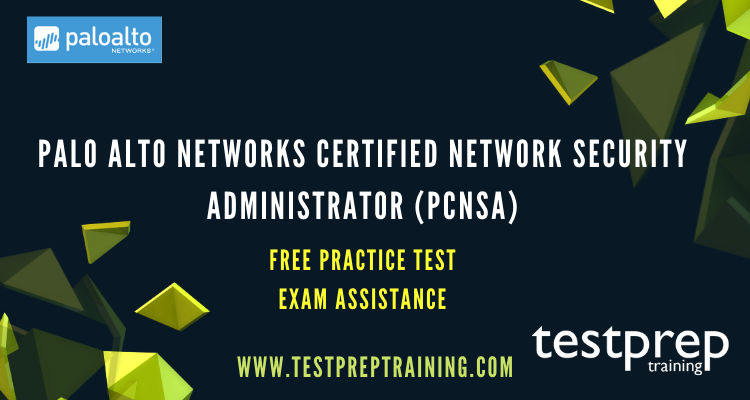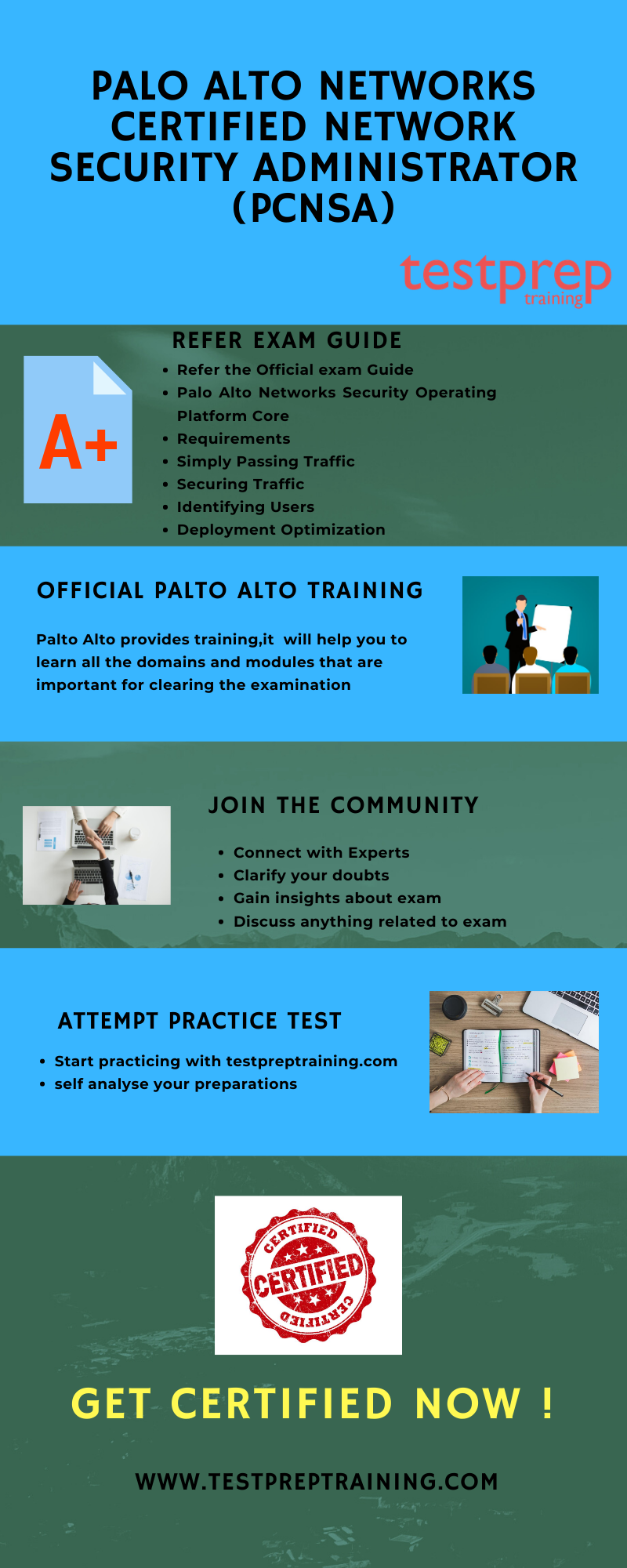Palo Alto Networks Certified Network Security Administrator (PCNSA)

Palo Alto Networks Certified Network Security Administrator certification helps the network security administrator to develop the knowledge required for deploying and operating the Palo Alto Networks Next-Generation Firewall(NGFWs). It assists the applicant in acquiring the necessary skills to operate in the field of cyber-security. People who manage Palo Alto Networks Next-Generation Firewalls to safeguard networks from cutting-edge cyberthreats are targeted by the PCNSA.
Target Audience:
- The Palo Alto Network Certified Network Security Administrator exam is designed to assist network security administrators and IT candidates.
- It’s a good addition for individuals looking to grow in the field of information security.
Prerequisite:
- There is no official prerequisite required for this examination. However, it is suggested that the candidate should complete Firewall Essentials: Configuration and Management (EDU-210) course to get a better insight and in-depth knowledge of the Palo Alto Network Certified Network Security Administrator certification.
Exam Details
- The Palo Alto Networks Certified Network Security Administrator (PCNSA) examination is a multiple-choice examination.
- The total number of questions in the examination is 50 and the cost is $140 USD.
- The total time duration of the examination is 80 minutes.
Exam Registration Palo Alto Networks Certified Network Security Administrator
For registering you are required to follow the steps below:
- Create an account on Pearson VUE. If you already have an account on Pearson VUE, then login to the account.
- Search the examination name Palo Alto Networks Certified Network Security Administrator (PCNSA).
- Select a location, and then register for a seat.
- Follow the prompts to register and make the payment.
Course Outline
Domain 1 – Palo Alto Networks CyberSecurity Portfolio Core
- Identify the components of the Palo Alto Networks Cybersecurity Portfolio
- Identify the components and operation of a single-pass parallel processing architecture.
- Given a network design scenario, apply the Zero Trust security model and describe how it relates to traffic moving through your network.
- Identify stages in the Cyber-Attack Lifecycle and firewall mitigations that can prevent attacks.
Domain 2 – Simply Passing Traffic
- Identify and configure firewall management interfaces.
- Identify how to manage firewall configurations.
- Display and schedule dynamic updates.
- Configure internal and external services for account administration.
- Given a network diagram, create the appropriate security zones.
- Identify and configure firewall interfaces.
- Given a scenario, identify steps to create and configure a virtual router.
- Identify the purpose of specific security rule types.
- Identify and configure security policy match conditions, actions, and logging options.
- Given a scenario, identify and implement the proper NAT solution.
Domain 3 – Traffic Visibility
- Given a scenario, select the appropriate application-based security policy rules.
- Given a scenario, configure application filters or application groups.
- Identify the purpose of application characteristics as defined in the App-ID database.
- Search the potential impact of App-ID updates to existing security policy rules.
- Find the tools to optimize security policies.
- Identify features used to streamline App-ID policy creation.
Domain 4 – Securing Traffic
- Given a risk scenario, identify and apply the appropriate security profile.
- Identify the difference between security policy actions and security profile actions.
- Given a network scenario, identify how to customize security profiles.
- Identify the firewall’s protection against packet- and protocol-based attacks.
- Identify how the firewall can use the cloud DNS database to control traffic based on domains.
- Find how the firewall can use the PAN-DB database to control traffic based on websites.
- Discuss how to control access to specific URLs using custom URL filtering categories.
Domain 5 – Identifying Users
- Given a scenario, identify an appropriate method to map IP addresses to usernames.
- Given a scenario, identify the appropriate User-ID agent to deploy
- Identify how the firewall maps usernames to user groups.
- Given a graphic, identify User-ID configuration options
Domain 6 – Deployment Optimization
- Identify the benefits and differences between the Heatmap and the BPA reports.
Reference: Palo Alto Networks Certified Network Security Administrator Study Guide
FAQ Palo Alto Networks Certified Network Security Administrator
For more information about (PCNSA), click on Palo Alto Networks Certified Network Security Administrator FAQ.
Exam Policies
Every examination has a few exam terms and conditions to which the student should follow. PCNSA includes various exam policies to help candidates understand the terms and procedures for the certification exam. Some of them are:
- Exam Re-certification Policy
- The PCNSA certification is valid for 2 years from the date of passing the examination.
- The candidate showed to wait for six months after acquiring the certification before taking another PCNSA exam.
- To keep your certification in Active status, you must recertify by taking PCNSA or PCNSE exam.
- Exam Score Report
- You will receive your examination score right after completing your examination.
- You will get to know whether you passed or failed and receive a score report that shows your report and how well you performed in each section of the examination or knowledge domains.
- Cancellation Policy
- To cancel exam candidates must contact Pearson VUE or access your online Pearson VUE account to cancel your exam up until the scheduled start time of your appointment.
- Failure to cancel before your scheduled appointment time or to show up for your scheduled appointment will result in the loss of your exam money.
Preparatory Guide
Following this study guide will assist you in learning and comprehending the objectives of each exam. We provide you with the greatest learning tools to help you pass the exam.

1. Refer the Exam Guide
Before every examination, it is recommended to check and refer to the official exam guide. Palo Alto provides an official exam guide and material to help you ace the preparation of the examination. it’s time to go through the basic exam details.
2. Official Palto Alto Training
Palto Alto provides training for the Palo Alto Networks Certified Network Security Administrator (PCNSA) examination. This official course will assist you in learning all of the domains and modules that are required to pass the test. It is recommended that you follow this course in order to pass the exam.
3. Join Study groups
Joining study groups is an excellent method to become totally immersed in the certification test for which you applied. These groups will assist you in keeping up to know with any recent modifications or exam updates. In addition, both novices and professionals are represented in these groups. You are free to ask any test-related question or discuss the exam without the fear of being judged. Furthermore, you may start a debate about any exam-related concern or query here. You will receive the best possible response to your inquiry if you do so.
4. Practice Tests
It is critical to put what you have learned into practice so that you can examine your results. By practicing, you will be able to enhance your answering abilities, which will save you a lot of time. Furthermore, the optimum time to begin practicing exams is after you have completed one whole topic since this will serve as a revision tool for you.



